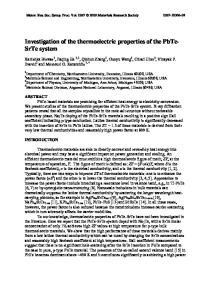The Effect on Thermoelectric Properties of Cd Substitution in PbTe
- PDF / 752,248 Bytes
- 6 Pages / 612 x 792 pts (letter) Page_size
- 2 Downloads / 375 Views
1166-N06-09
The Effect on Thermoelectric Properties of Cd Substitution in PbTe Kyunghan Ahn1, Mi-Kyung Han1, Derek Vermeulen2, Steven Moses2, Ctirad Uher2, and Mercouri G. Kanatzidis1 1 2
Department of Chemistry, Northwestern University, Evanston, IL 60208, U.S.A. Department of Physics, University of Michigan, Ann Arbor, MI 48109, U.S.A.
ABSTRACT A recent theoretical study suggested that the substitution of Cd in PbTe can result in a distortion in the electronic density of states (DOS) near the bottom of the conduction band in PbTe. In this study we explored the effect of Cd doping on the thermoelectric properties of PbTe in an effort to test the theoretical prediction that DOS distortion can increase the Seebeck coefficient. We present detailed investigation of structural and spectroscopic data, transmission electron microscopy, as well as transport properties of samples of PbI2 doped PbTe-x% CdTe (x = 1, 3, 5, 7, 10). All samples follow the Pisarenko relationship and no enhancement of the Seebeck coefficient was observed due to DOS distortions. A low lattice thermal conductivity was achieved by nanostructuring observed via high resolution transmission electron microscopy. A maximum ZT of ~1.2 at ~720 K was achieved for the 1% CdTe sample. INTRODUCTION Direct thermal-to-electric energy conversion using thermoelectric materials has been highlighted for the potential of fuel-efficiency improvement in passenger cars and trucks as well as power generation from waste heat generated by industrial plants.[1],[2] The dimensionless thermoelectric figure of merit, ZT = (σS2T)/κ, defines the efficiency of a thermoelectric material, where σ is the electrical conductivity, S is the Seebeck coefficient, T is the absolute temperature, and κ is the thermal conductivity. Significant enhancements in ZT have been recently achieved for both bulk materials and low-dimensional materials.[3],[4],[5] A recent theoretical study showed that resonance levels can be achieved when Cd is introduced on the metal sites of the PbTe rock salt structure [6] and this can lead to a significant enhancement in the electronic density of states (DOS). Most recently, Heremans et al. [7] reported that values of ZT for p-type Tl0.02Pb0.98Te reach 1.5 at 773 K due to an enhancement in the Seebeck coefficient through a distortion of DOS in the valence band. The substitution of Cd in PbTe is predicted to result in a distortion in the DOS near the bottom of the conduction band and thus can cause an enhancement in the Seebeck coefficient. In addition to resonance levels, a low lattice thermal conductivity can be realized through nanostructuring by the precipitation of CdTe due to a maximum solid solubility limit of CdTe in PbTe according to the PbTe-CdTe pseudobinary phase diagram[8]. In this study we explored the effect of Cd substitution on the thermoelectric properties of PbTe in an effort to test these theoretical predictions. We present detailed investigations of structural properties using spectroscopic measurements and transmission electron microscopy s
Data Loading...










